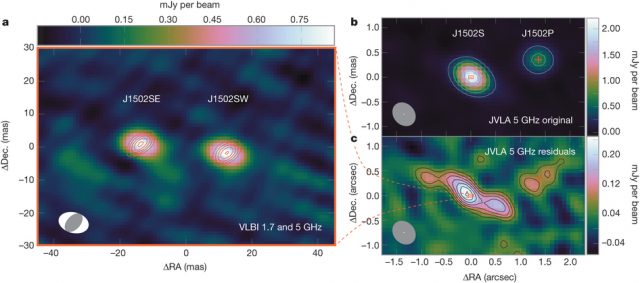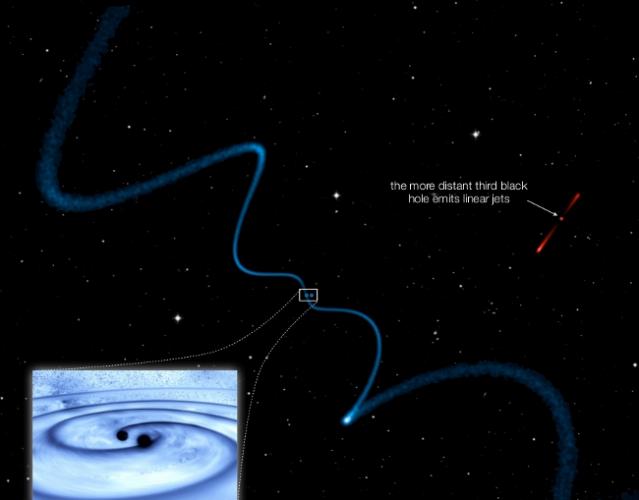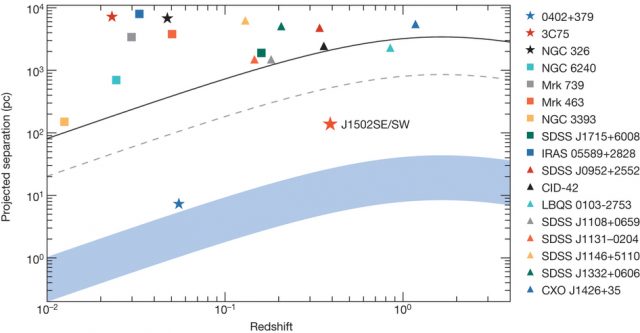Packed black holes
Black holes are not only gravitationally attractive: they also capture people’s attention. Just mention these two words in a course of elementary astronomy or in a public conference and you will find most eyes wide open. Even though they are common in observational astronomy, their singular physics and their fantastic dimensions makes them earn a well-deserved first place in the astronomical imaginary. From a purely scientific point of view, we are very lucky to have these behemoths in our Universe: they are interesting not only by themselves but also by the way they make visible what would be otherwise invisible.
Black holes come in two basic flavors: stellar-size and supermassive. The former type is the result of the stellar evolution while the latter has a more uncertain origin but they are supposed to reside in most, or even all, galactic centers. Let’s focus on these ones. If galaxies are formed by merging, it should be relatively common to find systems with two or more supermassive black holes. The first triple system was reported in the eighties 1 but as of June 2014 only three more triple systems were known, none of them really packed. We would consider a system packed if objects are closer than their gravitational sphere of influence, or the black hole’s Hill sphere, to put it this way. While a black hole with 109 times the Sun’s mass will have a sphere of influence with a radius of about one hundred parsecs, the closest pairs were in the order of a few kiloparsecs away.

This picture has changed with the publication of a recent work by Deane and collaborators showing the existence of a triple system whose close pair members are only 140 pc away from each other 2. This system is the most distant of all the known triple systems (z = 0,39) and it resides in a previously known quasar. The quasar had been imaged with adaptive optics in the past and thought to be a binary system 3 with components J1502S and J1502P. However, when Deane and collaborators performed Very Long Baseline Interferometry (VLBI) observations at 1.7 GHz and 5 GHz with the European VLBI Network (EVN) they found two distinct components within J1502S, nicknamed J1502SE and J1502SW. It is possible not only to measure the mass of the combined S sources (some 2.4 x 1011 solar masses) and for the P isolated source (1.7 x 1011 solar masses) but also to estimate the mass of the three black holes, all within the range of hundreds of millions of solar masses. The authors of the work discussed here even reanalyzed archival observation in order to confirm the detection of the triple system.

One of the most interesting results from the work of Deane et al. is that the jets emitted by the close binary resemble those of other X-ray binary sources. The helicoidal jet sketched in Figure 2 had been predicted for precessing jets at binary black holes but have not been found yet. This is exciting, since it provides an excellent way of finding binary systems that cannot be resolved using current instruments. Another appealing consequence of this work is the raw statistics implied by the analysis. The authors state that they have found this triple-with-close-binary system after only inspecting six galaxies which suggests that tight pairs could be more common than previously thought. We all know that statistics can be tricky, but a look on the binary systems detected so far seems to favor this conclusion.

Which are the implications of this work on a broader perspective? As previously stated, it is commonly accepted that galaxies are formed by pair mergers. Being able to detect tight pairs means being able to trace the merger history of the Universe. This study is a call for higher spatial resolution instruments if we want to witness galaxy formation and evolution. Moreover, such close binary systems are expected to emit gravitational waves as predicted by General Relativity. By 2020, when the Square Kilometre Array radiotelescope will be constructed, we will have the tool for seeing those gravitational waves in action emitted by packed black hole sytems as the one described by Deane’s work. So, after all, we see that the attention driven by supermassive black holes is really well deserved. It is not only that they are huge and startling, is that they can give us the clues for a better understanding of the Universe.
References
- J.L. Tonry (1984). Constraints on the orbits of multiple nuclei in brightest cluster galaxies. The Astrophysical Journal 279, 13-18. doi: 10.1086/161861 ↩
- Deane R.P., M. J. Jarvis, M. Coriat, G. Bernardi, R. P. Fender, S. Frey, I. Heywood, H.-R. Klöckner, K. Grainge & C. Rumsey & (2014). A close-pair binary in a distant triple supermassive black hole system, Nature, 511 (7507) 57-60. DOI: http://dx.doi.org/10.1038/nature13454 ↩
- H. Fu et al. (2011). Mergers in double-peaked [OIII] active galactic nuclei. The Astrophysical Journal, 733, 103-110. doi: 10.1088/0004-637X/733/2/103 ↩
2 comments
[…] [Leer la entrada completa en Mapping Ignorance] […]
[…] Zulo beltz supermasiboak ia galaxia guztien erdigunea hartzen dute. Eta, galaxiak beste galaxia bi edo gehiagoren fusioari esker sortu badira ez da arraroa zulo beltz supermasibo bi edo gehiago dituzten sistemak aurkitzea. Izan ere berriki plazaratu den lan batek […]